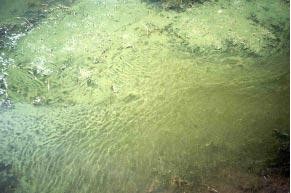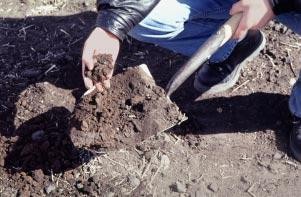Best management practices
Sustainable agriculture requires that soil and water quality be maintained. Some farm practices have the potential to cause environmental harm, which may affect rural and urban areas alike. Many of the potential negative impacts of farming can be greatly reduced by the use of Best Management Practices. These are agricultural practices that reflect current knowledge about conserving soil and water without sacrificing productivity.
Water is continually cycling. The water that we use has been used before. Producers and consumers, rural and urban people and the public and private sectors, are all responsible for using water wisely and ensuring that the resource is maintained for others. Best Management Practices are one way for the agricultural sector to help preserve water quality.
Introduction
In order to grow, plants need light, heat, mechanical support, air, water, and nutrients. These are called growth factors. The level of growth cannot be greater than that allowed by the most limiting growth factor. In the Prairie region, growth is most often limited by water. That is why irrigation almost always increases yields. After water, plant nutrients are most likely to be limiting factors.
The information below provides information on the impact of plant nutrients on water quality and how the careful management of nutrient inputs can mean economic efficiency for producers and improved water quality for others.
What are plant nutrients?
Plant nutrients are comprised of the fourteen essential elements that plants obtain from the soil. Some are required in relatively large quantities. Others are needed only in very small amounts. In soils, the nutrients most likely to be limiting are nitrogen and phosphorus. When soil nutrients cannot produce a good crop yield, additional nutrients must be added. Applying too little nutrient will limit yield. Applying too much does not make economic sense and can harm the environment.
The level of water in the barrel represents the level of plant growth. Even though the other growth factors are present in more than adequate amounts, growth can be no higher than that allowed by the shortest stave (nitrogen in this example).

Description of the above image
The above image is of a barrel with staves of varying heights each representing the presence of a different plant growth factor. Light, mechanical support and air are all completely present but heat, organic matter, potassium, phosphorus, other nutrients and water are lacking. The lowest growth factor represented on the barrel is nitrogen and water can only fill the barrel to the height of the lowest stave just as plant growth can only continue as long as all the growth factors are present, once one factor is lacking growth ceases.
How do plant nutrients affect water quality?
The aquatic plants and algae in streams, lakes, ponds and marshes also use nutrients to grow. These plants and algae are an important component of the water body because they produce oxygen and provide food and shelter for fish and other aquatic life. There are enough natural sources of nutrients to allow these plants to grow.

If additional nutrients from fertilizers and manure get into the water, growth of plants and algae will increase.
Excessive growth of algae is called a bloom. Algal blooms sometimes produce compounds that can be toxic to livestock. When water is fouled with plants and algae, recreational uses of the water such as swimming and boating are no longer enjoyable. When the plants start to decompose, the dissolved oxygen in the water will be depleted. Lack of oxygen can lead to fish-kills.
How do nutrients get into water?

Nutrients are contained in fertilizers, manures and crop residues. The nutrients in these sources are present in both organic and inorganic forms. Plants can only use nutrients that are in an inorganic form. Eventually, organic forms of nutrients are converted into inorganic forms, but this can take several months.
If excessive fertilizer or manure is applied, the nutrient surplus will be available for transport to water. Many inorganic nutrients are easily dissolved in soil water and can be quickly transported to surface or ground water by leaching or through runoff. Organic nutrients can be transported to surface water through runoff and will also eventually be converted to inorganic forms and become available for algae and aquatic plants to use.
What is nutrient management planning?
Nutrient management planning is a best management practice that aims to optimize crop yield and quality, minimize fertilizer input costs and protect soil and water. The principles of this are simple and include:
- applying fertilizer only to make up the difference between what is there and what is required to achieve the target yield, which also ensures cost-effectiveness for the producer; and
- ensuring that the added nutrient is available to the crop.
Nutrient Balance Equation:
In other words - the right amount, the right product, in the right place, at the right time.
The right amount
The first step in determining the amount of fertilizer to add is to estimate how much is required for a target yield. A realistic yield goal takes account of climate, soil and management limitations. Remember that water is the limiting factor in most of the Prairie region. Large fertilizer additions are wasted when a crop is short of water.
Good yield forecasting relies on understanding how crops respond to fertilizer under different conditions. Soil testing laboratories can provide this information when samples are provided for testing.
A target yield should also be based on the projected selling price and a decision about the financial returns for each cost unit of fertilizer. As soil fertility increases, the amount of yield increase begins to decline. Economists refer to this as diminishing returns.

Soil testing is an essential part of
nutrient management planning.
The next step is to determine nutrient levels in the fields. This can only be done by soil testing. Test results are a best approximation of the level of nutrients that are available to plants before fertilizers are added. The right amount of fertilizer to add is determined by the difference between the requirement for a target yield and the nutrients that are already in the field. This is the other job that soil testing laboratories can do.
In the Prairies, nitrogen, phosphorus and in some areas, potassium and sulphur are the main ingredients of fertilizer blends. From the perspective of water quality, nitrogen and phosphorus are the elements that pose the greatest potential problems. When fertilizing, it is important to keep equipment well-calibrated to ensure that the intended application rate is maintained.
The right product
Once the amount of nutrient to be added is established, the type of product has to be chosen. If manufactured fertilizers are used, the selection of a blend is based on the balance of the nutrient requirement.
If manure or other organic fertilizers are used, it is more difficult to calculate the amount of product required. All organic fertilizers, manure in particular, vary greatly in terms of nutrient content. As well, when organic fertilizers or manure are applied to a field, only some of the nutrients are available for use by the next crop.
For nutrients to be available to plants, they must be transformed into inorganic forms in the soil. The rate at which this occurs varies greatly. The organic fraction remains in storage in the soil and is released in plant available forms over time. When planning to supply the majority of a fertilizer requirement with manure or other organic products, consultation with a professional agrologist or crop specialist is recommended.
When applied to land in large quantities, manures present other water quality concerns that chemical fertilizers do not. These include runoff containing disease-causing organisms and organic matter.
The right place
Generally, nutrient additions should be placed as close to the growing plant as possible without damaging the crop. The greater the distance between the plant and the fertilizer, the greater the chance that it will be lost before it can be taken up. Where nutrients should be placed, however, is governed by many factors.
Effective placement depends on the formulation of the fertilizer, the crop, soil properties, moisture conditions and the equipment used. From a water quality perspective, fertilizers that cannot be reached by the roots of a crop are at risk of being lost to surface or ground water. This is particularly true for broadcast applications. Without incorporation, the chances of runoff are much greater.
The right time
The right time to apply fertilizers is as close as possible to the time that plants need the nutrient. Loss of nutrients increases with time. Surface applications of chemical fertilizer or manure in the fall or winter, without incorporation, are not recommended in northern climates. This is because the removal of nutrients through snow melt water is high.
Generally, crops require the greatest amounts of nutrients at the times of fastest growth and seed production. Some nutrients, if applied too early in the season, may be transported out of the root zone with runoff or infiltrating water prior to the time of peak demand. Post-seeding treatments and slow-release products offer some alternatives to traditional applications at the time of seeding.
The big picture
Plant nutrients that escape from farms to fresh water can greatly affect water quality for other uses. The impacts may be experienced by the farm itself, in the form of poor quality drinking or domestic water, or by other users downstream. Fertilizers represent a major input cost for producers. Any reduction in amount applied, without crop yield loss, represents a cost saving.
Understanding the principles behind nutrient management and incorporating them into farm management is a winning strategy for everyone.
Fertilizer efficiency is increased and unwanted additions of plant nutrients to surface and ground water are reduced. By maximizing your returns from inputs and avoiding unnecessary expenditures on wasted nutrients, you can improve your bottom line.
We all want agriculture to be sustainable in the long-term. Nutrient management planning can contribute to your success in agriculture.
Authored by: C. Hilliard and S. Reedyk